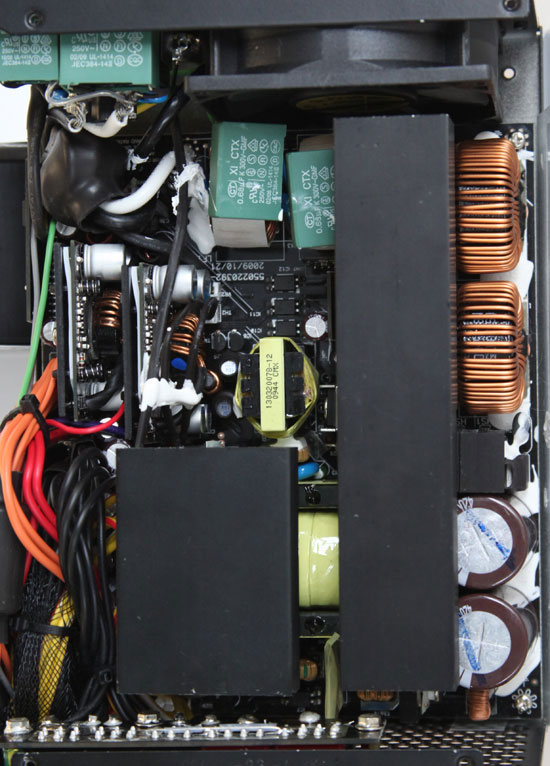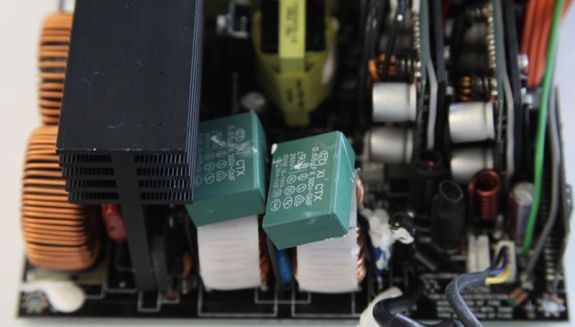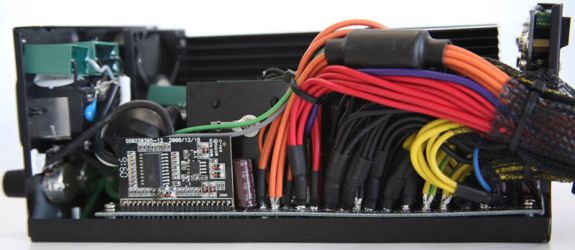Antec TruePower Quattro 1200W
by Jarred Walton on July 7, 2010 6:50 PM ESTInterior and Topology
The internal structure of the ATX 2.3 PSU is dominated by two very big heatsinks. This is one reason the 80mm fan can be as silent as other PSUs with 120mm or larger fans. You just need the right topology and an efficient design. However, the heatsink on the secondary circuit is much smaller, as there are many components for filtering and regulation. The main capacitors are from Nippon Chemi-Con as well as on the secondary side with some additional all-solid caps from Sanyo on the VRMs.
Antec is using a well equipped EMI-filter with nice isolated x-capacitors and two PFC-chokes in this interleaved design. We can see two Infineon transistors for switching. They are absolutely famous these days because of their good transmission characteristics. Of course, there are interference-suppression chokes on each rail and a MOV behind the entrance. The safety-distance between the galvanic isolated circuits is more than enough.
Because of the numerous cables and big heatsink there is not much space on the secondary side. We will see if this presents a thermal problem under high load. Most of the wires have shrink tubing. The Silicon Touch IC offers SCP, OVP, UVP and OCP.













29 Comments
View All Comments
bobbozzo - Friday, July 9, 2010 - link
Most houses in the US have 20A circuits, but 15A outlets.Klinky1984 - Saturday, July 10, 2010 - link
A lot of people buying this probably don't need 1200 watts. There is some prestige to having a 1.2kW PSU, but what kind of system is really going to stress this power supply? Maybe if you got one of those 7x PCIe x16 motherboards and created a GPU distributed computing number cruncher, perhaps. But I'd think a more typical tri-SLI setup would have problems pushing 50% usage on this thing.Klinky1984 - Saturday, July 10, 2010 - link
Well, perhaps I underestimated the power-fatty Fermi is.cactusdog - Thursday, July 8, 2010 - link
This doesnt appeal, there are much better options out there with truly silent 140mm fans. Most new high end PSUs are going back to a single rail too.HOOfan 1 - Thursday, July 8, 2010 - link
>most new high end PSUs are going back to single railI wouldn't say that at all....some companies want single rail, but I think MOST is a serious exaggeration.
Why does it matter anyway?
Stuka87 - Thursday, July 8, 2010 - link
If you buy a cheap supply, its going to be cheap. Regardless of the brand. I have a mid-range Antec and I have been very happy with it. Its quiet, and it weighs about 3x more than the cheaper PSU it replaced.doctormonroe - Thursday, July 8, 2010 - link
I'm not a big fan of having less than a 120mm fan, but the reviewer covered it when he said that you'd hear the rest of the system before a 1200W PSU under load.I'm glad that you've stopped using the charts that were in previous articles (as they were not easy to read and comprehend), but good charts are much better than tables, so hopefully soon you'll figure out a good chart to use.
HOOfan 1 - Thursday, July 8, 2010 - link
Yeah...that happens. It happens with anything...especially with electronics.What model was it? If it was REALLY one of their halo products, I am not sure how you came to the conclusion that it was built cheaply.
Of course you have some people who think the PSU is such a simple design and that there is no excuse for a well built PSU to fail. People like that just make me roll my eyes...and usually ignore them from then on.
Martimus - Thursday, July 8, 2010 - link
Antec used to have a reputation for using low temperature Caps that would fail at actual operating temperatures over time. I had assumed that they stopped doing this, but it is possible that they still use this practice.TGressus - Thursday, July 8, 2010 - link
In general the more popular ODMs will have a portfolio of designs. Some better than others. In my experience this is where some of the vendors get away with shady practices. Entry level components get hidden within a shiny exterior, marketed as something they are not and no one is the wiser.I'd like to see the status quo among reviewers/enthusiasts change to focus on relative comparison, and historical performance of the ODM models inside PSUs. As it stands now we tend to focus on a visual inspection, and essentially a second wave of manufacturer QC testing.
When we discuss SSD or GPU we consider the chipset first, and the brand second. This enables the community to make better informed decisions, and allows us to steer trends in product development, rather than the vendor hooride that is the PSU market.